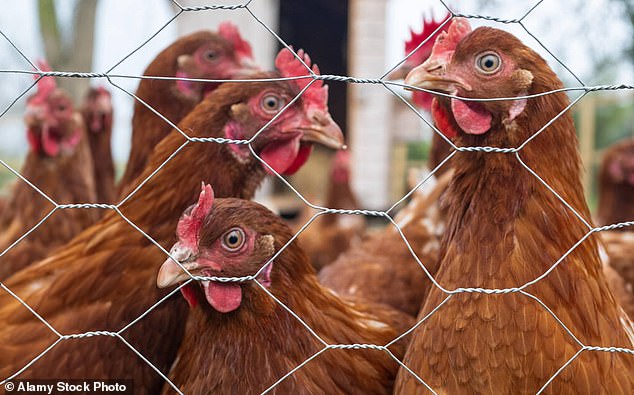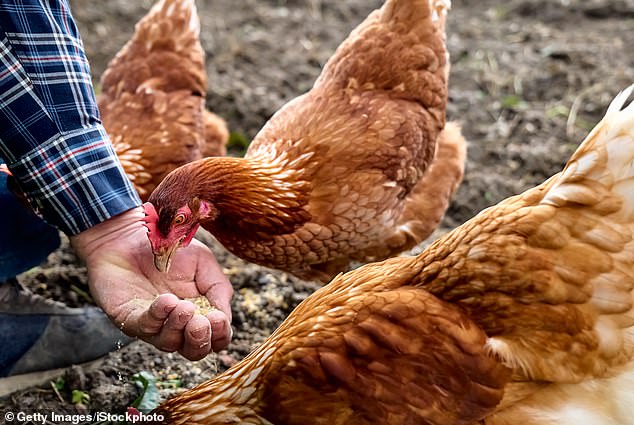How to Talk to Your Chickens: Scientists say you can tell whether birds are happy, sad, tired or lonely by their CLUCKS. Can you decipher these sounds?
Can you tell if a chicken is happy or in a fowl mood?
Scientists say chickens don't have a bird brain, but they actually live complex emotional lives.
From anxiety and depression to excitement and contentment, chickens can display a wide range of emotions.
And you don't have to be Doctor Dolittle to find out how they feel, because research shows that people are good listeners to our poultry friends.
So whether it's a rapid barrage of clucking or a loud scream, this is what your chicken's sounds really mean.

Scientists say chickens can display a wide range of emotions, from fear and anger to happiness and excitement
Researchers from the University of Queensland's School of Veterinary Science discovered that chickens produce different sounds depending on whether they are happy or sad.
The scientists recorded the calls of chickens that heard a sound signal and received a reward, as well as those that heard the signal but received no reward.
When the chickens expected to be given a treat, they made two different types of noises: a barrage of noise called “rapid clucking” and the high-pitched “food call.”
Anticipation and curiosity are important emotions for chickens, who spend most of their day foraging and foraging for food.
Professor Christine Nicol of the Royal Veterinary College, an expert on chicken behavior, says chickens seem to seek out this sense of anticipation.
Speaking to Backyard Poultry, she said: 'Even when given easily accessible food, they prefer to scratch and explore the dirt and wander around in search.
'The actual activity of foraging seems to be rewarding in itself.'
Professor Nicol adds that 'chickens trained to associate a sound with an impending delivery of mealworms became more alert and showed more preening and wing beating.'


You don't need a Dr. Dolittle to speak chicken, because research shows that most people can already tell when chickens are happy or sad
Conversely, the same study found that when chickens were disappointed by the lack of a treat, they responded with a high-pitched whine and a low, hesitant call called a “gackle.”
Professor Nicol explains that chickens can feel frustration when they don't have access to the resources they need.
This can lead to chickens venting through other irrelevant behaviors in a process called “displacement.”
For example, a chicken that has not had a dust bath may go through the motions of bathing or search for a long time.
Professor Nicol even says that chickens can become anxious and make a lot of distress calls, or become depressed and stop making calls altogether.
However, if all this talk about food calls and gawks sounds difficult to understand, don't worry.
The researchers found that 69 percent of 200 volunteers could determine whether a chicken was happy or disappointed based on a recording of its clucking alone.
But excitement and disappointment are far from the only emotions that chickens can express.
Professor Adrian David Cheok, a researcher from the University of Tokyo, created an AI that could distinguish different emotional states in chickens.
By training an AI on 100 hours of chicken sounds, the algorithm learned to identify hunger, fear, anger, satisfaction, excitement and fear.


Chickens release a rapid barrage of cackles or a high-pitched staccato cackle when anticipating receiving food
Previous research has provided an even finer analysis of chickens' emotional communication.
Nicholas and Elsie Collias, both at the University of California, identified 24 different chicken sounds, each with a different purpose.
These range from the 'singing' or 'quacking' of the cry of contentment to the nagging moan of 'light disturbance'.
The calls of fear and distress in particular are very varied.
Male chickens will produce different alarm calls depending on whether a predator is approaching from the air or on the ground and how fast it is moving.
Research has even shown that chickens exhibit empathy or “emotional contagion” when they perceive the suffering of others.
Researchers from the University of Bristol found that when chicks were disturbed with a whiff of air, their mothers showed signs of distress.
They noted that the chickens showed a higher heart rate and lower eye temperature, as well as increased alertness, less preening and more vocalizations directed at their chicks.
